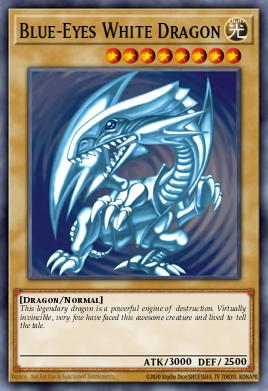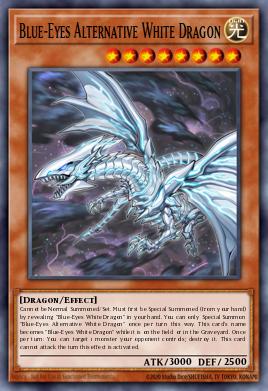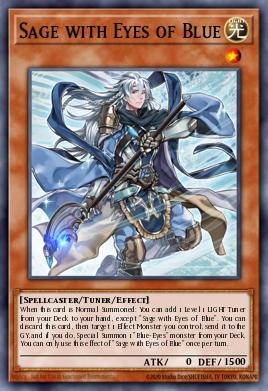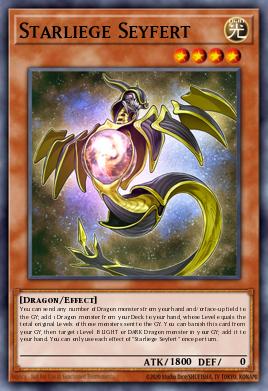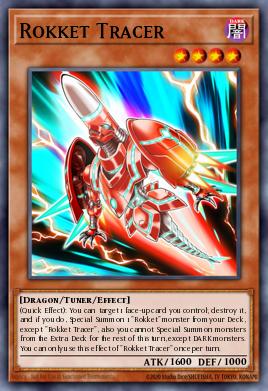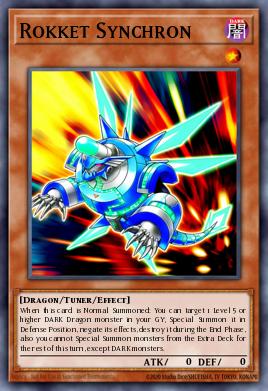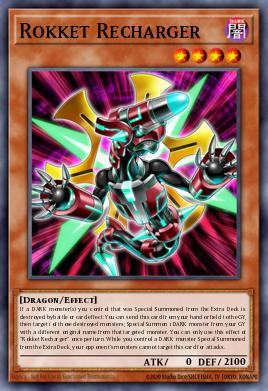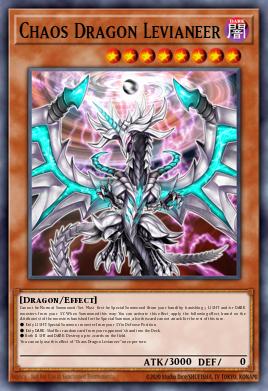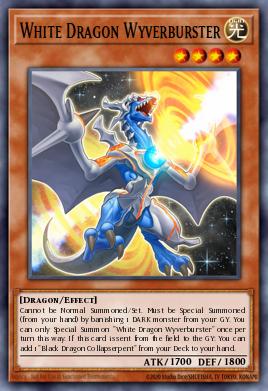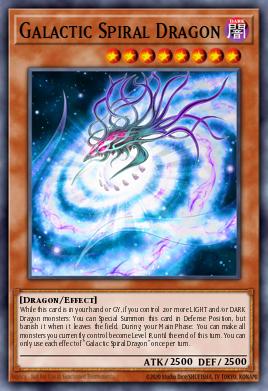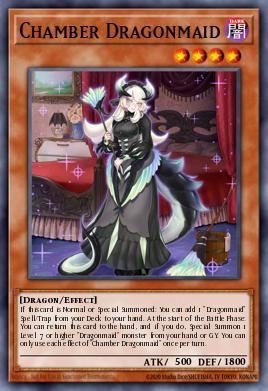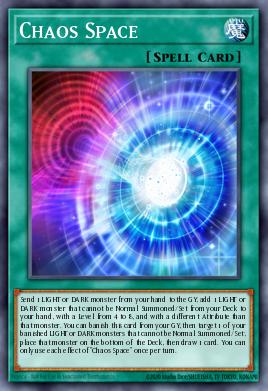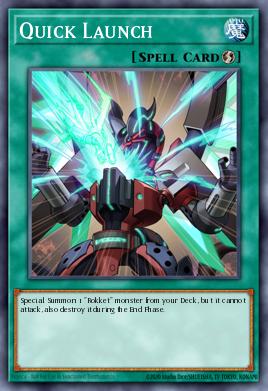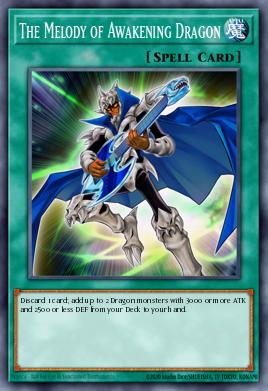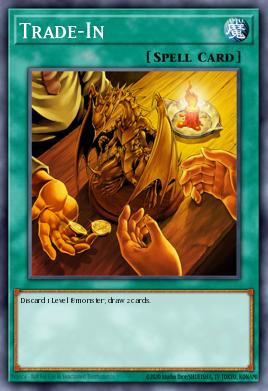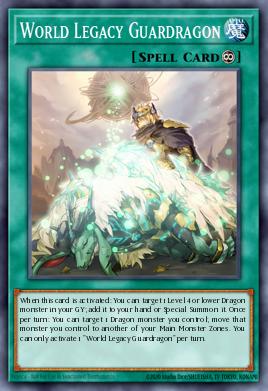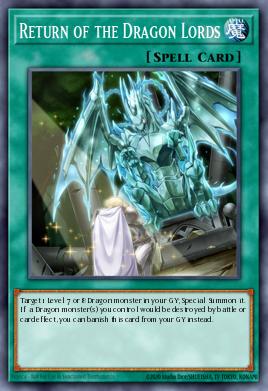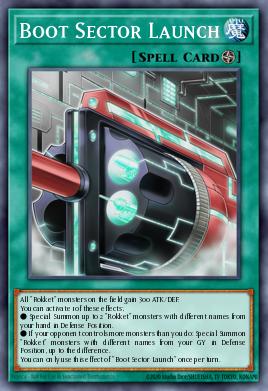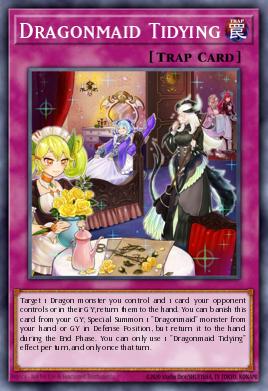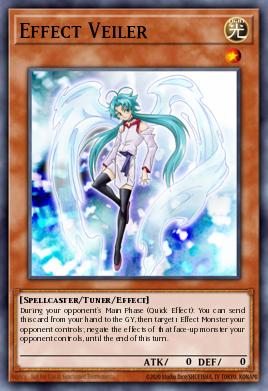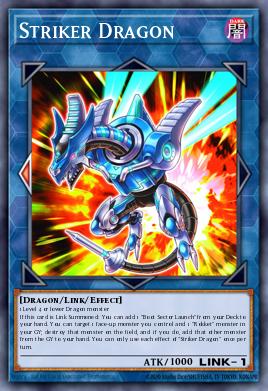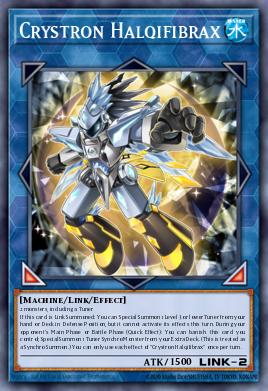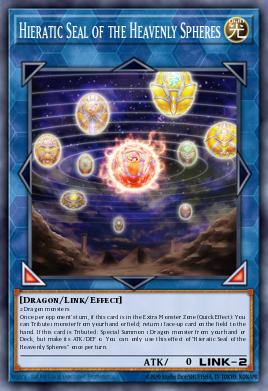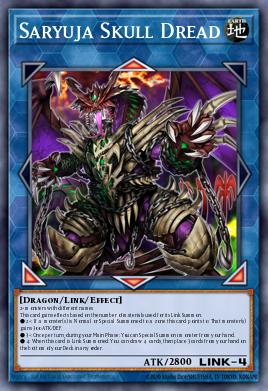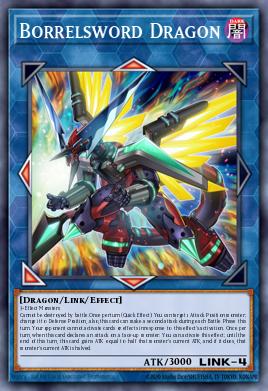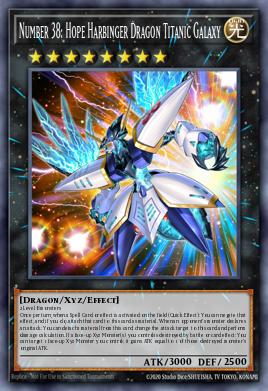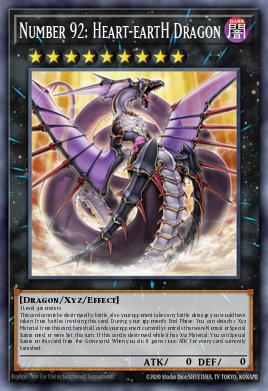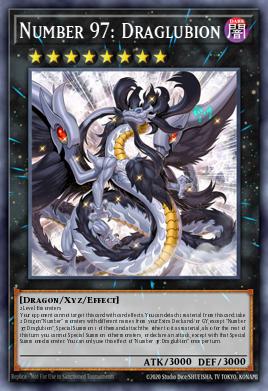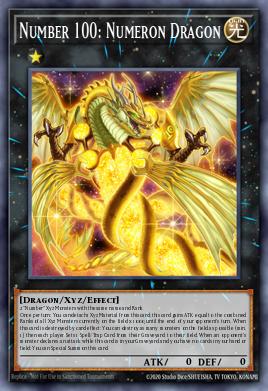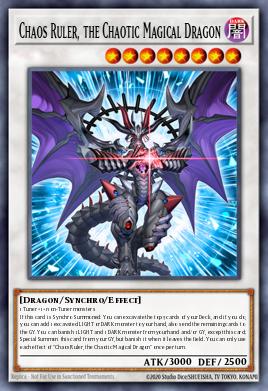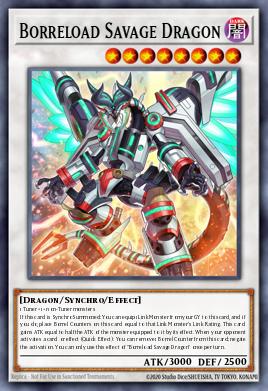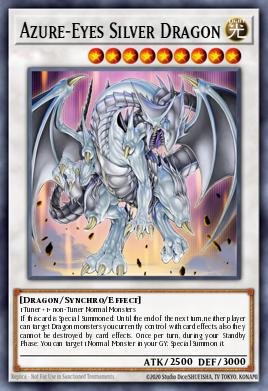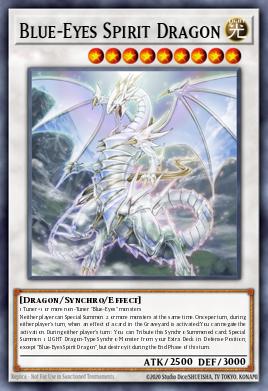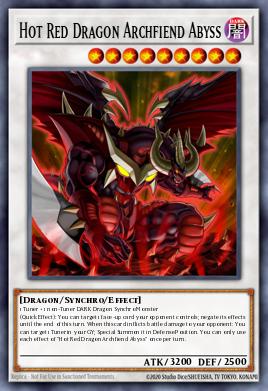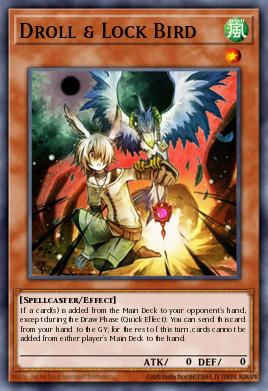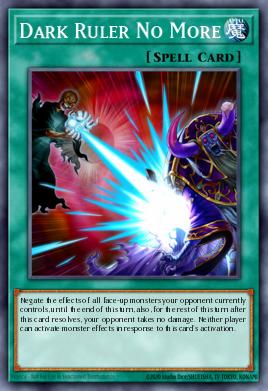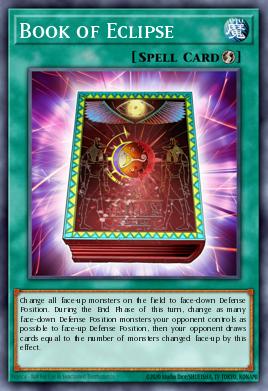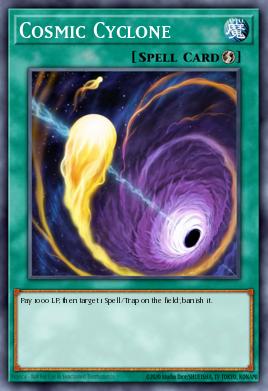Blue-Eyes White Dragon Link: Theory & Practice
Deck Primer
Let's make this clear right off the bat: This is absolutely not 'the best Blue-Eyes deck ever'. I'm skeptical of anyone even claiming that distinction. This is the Blue-Eyes Dragon Link deck I built and saw some success with at locals. But I've decided to profile it here in order to draw out some general theory about the game as a whole and Blue-Eyes in particular. The first half of this profile opens with these more general points on theory. The second half covers the deck itself, outlining some key combos, card choices and the extra-deck. Pay no heed to the side deck here--it's more or less a straight holdover from the list I actually ran a few months back.
Blue-Eyes White Dragon & its Contradictions
I started playing YuGiOh again in July 2021 after a nearly two-decade hiatus. Like countless nostalgic millennials re-visiting the game, I gravitated toward the familiar and set to work building a Blue-Eyes White Dragon deck. Blue-Eyes White Dragon may not be the ultimate creature of destruction, but there's no question it's the ultimate creature of fixation among a huge swath of YuGiOh players.
Naturally, Blue-Eyes players have developed countless builds and strategies to play the deck, even as it remains totally irrelevant to the competitive meta-game. Some prefer a purer Blue-Eyes deck that focuses entirely on the monster, its surrounding archetype and the sizable amount of support churned out by Konami over the years. More competitive-minded players, however, typically build Blue-Eyes decks that borrow from other archetypes and strategies to boost the deck's power, consistency and more. It should be said, none of these decks compete any higher than certain local tournaments--and even at that level, some cannot compete at all.
The Four Main Blue-Eyes Decks
At present, there are four generally accepted ways to build a Blue-Eyes deck: (1) Fusion, which is based around summoning Blue-Eyes fusion boss monsters like Blue-Eyes Alternative Ultimate Dragon; (2) Ritual, which aims to summon monsters like Blue-Eyes Chaos MAX Dragon for an OTK; (3) Rank-8, which uses the Blue-Eyes archetype and engine to make powerful rank-8 XYZ monsters; and (4) Dragon Link, which uses the Blue-Eyes engine alongside more common dragon-based engines to combo into a typical DLink end-board that includes negates and interruptions along with powerful boss monsters. These four deck builds are not always rigid and often overlap, incorporating some elements of one or the other. Most Blue-Eyes players, for instance, run some type of rank-8 XYZ package in the extra-deck, even if it's not the deck's main focus. But in general, these are the four major types of Blue-Eyes decks in the current format.
Among these four, the ritual build is generally accepted as stronger than the fusion build. Whether it runs an Impcantation engine to turbo out its ritual monster, works Chaos MAX into Drytron, or sticks to the typical archetypal support, the ritual build seems to have an easier time getting its win condition onto the field than the fusion build does--though I should add, this may change significantly with the release of the Battle of Chaos support cards in February 2022. Blue-Eyes fans tend to prefer these two, no doubt owing partly to their appearances in the Duel Monsters anime.
While both can reliably pump out their boss monsters, they do so at an enormous cost. Beyond running the BEWD normal brick at x3--or perhaps because they do so--the decks have to run a certain amount of support cards that mitigate the risk of drawing an unplayable hand. But they also have to run enough searchers to get their Blue-Eyes pieces from deck to hand, field and/or graveyard. This leaves relatively little deck space for defense and disruption if the player aims to keep their deck size at or around 40 cards.
More issues soon arise. Under the right circumstances, both Chaos MAX and Alternative Ultimate Dragon can OTK their opponent--and if not, they can rampage through opponent's boards with their powerful effects and high attack. Both have some level of built-in protection too. But in the present-day meta-game, these are easily worked around since neither creature has the ability to negate anything. If the opponent succeeds in disrupting their play, it usually means the end of the game due to the player having committed so many resources in summoning the Blue-Eyes boss monsters in the first place.
'Brick-Eyes' White Dragon & Card Economy
Since its victory at the 2016 YuGiOh World Championship, which itself was not without controversy, Blue-Eyes decks have remained outside the scope of competitive play in all but the local level. On a fundamental level, the deck's consistency will always suffer due to the Blue-Eyes White Dragon itself. As a level-8 normal monster with 3000 ATK / 2500 DEF, Kaiba's ace monster is just a beat-stick--solid stats but hardly unique among boss monsters. It requires two tributes to normal summon to the field, meaning it's not capable of starting plays. It also has no card effect. Other cards can make use of BEWD to start plays or extend the player's position (Trade-In and Blue-Eyes Alternative White Dragon, respectively), but the vanilla BEWD is neither a starter nor an extender. It is an absolute brick that will simply sit in-hand if you fail to draw into the right card.
While YuGiOh has no direct analog to Magic the Gathering's mana economy, the game absolutely has a resource system. Resources in YuGiOh are the cards a player has access to using at any given time, whether in-hand, on-field, or in-grave. All other things being equal, the deck that generates greater card advantage than an opponent's deck is better situated to win. Card advantage generally represents more available options for making optimum plays and counter-moves. Pot of Greed is banned for this very reason. This concept is pretty YuGiOh-101, but it helps us understand the trouble with Blue-Eyes decks.
Running 3x BEWD equates to a more than 33% chance of seeing at least one of these cards in the opening five-card hand of a 40-card deck. In the likely event that a player draws into at least one unusable Blue-Eyes brick, they are beginning the round at a potential disadvantage (potential because the opponent can brick too). Drawing 1x BEWD in the opening five cards means that 20% of your available resources are unusable on their own as either starters or extenders. Perhaps the player draws into Trade-In, which upon activation essentially swaps 1x BEWD and 1x Trade-In for two new cards. In some sense, this generates additional resources in that seven (7) cards are now available in-hand or in-grave. It also thins the deck, boosting the probability of drawing into important extenders.
Trade-In is a good spell that Blue-Eyes decks consistently run at x3 for precisely this purpose. In another sense, however, both BEWD and Trade-In represent opportunity costs to the deck. For one, they both showed up in-hand rather than better starters or superior extenders. Trade-In essentially fixes a bricked hand by replacing an unusable card and itself with two new cards, one or both of which may be useful. Resolving Trade-In thus becomes a necessity for playing this hypothetical hand.
This highlights another opportunity cost more fundamental than the composition of the five-card hand. Blue-Eyes decks have an ever-compounding need to run cards that mitigate their decision to run 3x BEWDs in the first place. Any Blue-Eyes player who has ever drawn another copy of Trade-In from resolving Trade-In has experienced this principle firsthand. From jump street, running Blue-Eyes White Dragon forces the player to include cards that will 'fix' their hands in-place of other starters, extenders or defense/disruption like hand-traps. The rest of the deck bends in service of a (fairly useless) card, rather than the card serving the functionality of the rest of the deck. Generally this is a bad way to deck-build.
BEWD and Dark Magician stand out as anomalies in YuGiOh due to their immense ongoing popularity. Konami has built these vanilla, two-tribute monsters into entire archetypes with their own lineup of supporting monsters and extra-deck monsters, along with a suite of spells and traps. Both regularly receive new support aimed--with varying degrees of success--at bringing these Duel Monsters anime icons up to speed with the game's modern mechanics. Much of this support focuses on lowering the barrier to summoning these bricky, beloved boss monsters, while some has offered in-archetype cards that offer useful alternatives to work around the more fundamental weaknesses of these decks--like the aptly named Blue-Eyes Alternative White Dragon.
Debate rages on among the fanbase of both monsters as to what Konami would have to release to make these decks competitive in the meta. At the core, the question is, how does a deck running so many bricks--remember, cards like Alternative White Dragon are bricks in-hand too without an accompanying BEWD to summon--and dedicating so much space to mitigating the bricks become consistent and powerful enough to compete? My own thoughts fall outside the scope of this already-long deck profile. But the contradictions presented in this question are why I maintain that, at present, the Dragon Link build is the strongest, most consistent way to run a Blue-Eyes deck.
Dragons of Dr. Moreau: Crossing Blue-Eyes with Dragon Link
Here's how the deck primarily works:
The Blue-Eyes engine runs alongside the other two main Dragon Link engines: Rokkets and Chaos Dragons. Through exploiting the White Stone of Legend's mandatory search effect, which triggers when sent to the graveyard, the player simultaneously builds a board, adds the 3x Blue-Eyes White Dragon to hand and, by removing these bricks, boosts the deck's draw consistency. Once in-hand, the 3x BEWD bricks become part of the deck's resource system, generating even greater card advantage and thus overcoming a major obstacle facing Blue-Eyes decks. The watershed moment happens when Saryuja Skull Dread is summoned using four (4) monsters as link material, resulting in the player drawing four (4) new cards and placing three (3) at the bottom of the deck. In essence, the player draws just shy of a second opening hand and has up to 3x BEWDs to put back into the deck, allowing them to grab critical extenders and disruption to build and defend their board while lowering the probability of drawing into bricks on future turns.
The Core Combo
The ideal opening hand consists of 1x Sage with Eyes of Blue and 1x Melody of Awakening Dragon. Barring disruption, the combo looks like this:
- Normal summon Sage with Eyes of Blue. Activate its effect to search the White Stone of Legend.
- Activate Melody of Awakening Dragon, pitching the White Stone of Legend for cost. The White Stone should be arranged as chain link-2 and resolve first, adding 1x BEWD to hand. Melody is chain link-1 and resolves after by the player adding 1x Blue-Eyes Alternative White Dragon and 1x Chaos Dragon Levianeer to hand.
- Special summon Blue-Eyes Alternative White Dragon by revealing BEWD in-hand. If going second, the player can activate Alternative's effect to pop a monster if appropriate since it will not be used in the Battle Phase.
- Link off Sage + Alternative to link summon Crystron Halqifibrax.
- Activate Halq's effect to special summon a second copy of the White Stone of Legend.
- Link off the White Stone of Legend to summon Striker Dragon to the bottom-right zone beneath Halq. White Stone's effect searches and adds 1x BEWD to hand.
- Activate Striker Dragon's effect to search Boot Sector Launch and add to hand.
- Special summon Chaos Dragon Levianeer to the main monster zone furthest away from Halq by banishing three (3) light monsters from the graveyard.
- On summon, activate Levianeer's effect to bring back one of the White Stones in the graveyard in defense mode.
- Link off the White Stone to summon Guardragon Pisty to the bottom-left zone beneath Halq. White Stone's effect searches and adds 1x BEWD to hand.
- Activate Pisty's effect to bring back one of the White Stones from the graveyard.
- Link off Halq, Striker Dragon, Pisty and the White Stone to summon Saryuja Skull Dread.
From here, the player can arrange the chain links to fit the situation. If Saryuja's effect is chain link-1, the White Stone will have no valid targets to search and not resolve. If the White Stone is chain link-1, however, Saryuja's effect resolves first and the player will draw four (4) cards and then select three (3) to place at the bottom of the deck. If 1+x BEWDs are placed in the deck by Saryuja's effect, the White Stone's effect will resolve and add one (1) of the copies of BEWD that you just placed at the bottom of the deck back to your hand. This means that even if having a BEWD in-hand is useful for activating cards like Trade-In, you should still generally put them back and take advantage of the White Stone's effect trigger by arranging your chain links to resolve this way.
If all three (3) copies of BEWD are in-hand at the time of Saryuja's summon, the White Stone's effect will not resolve and cannot chain-block so you mind as well make it chain link-1. Occasionally, however, you may get to Saryuja with one or more copies of BEWD still in the deck, in which case the White Stone's effect can chain-block to protect Saryuja's draw effect from disruption.
Depending on the opening hand, Chaos Space can act as a partial replacement for Melody if one if drawn but not the other. After all, it can search and add either Chaos Dragon Levianeer or Blue-Eyes Alternative White Dragon, and it can pitch any light or dark monster (White Stone of Legend) as cost. One of the handful of DLink mechanics that actually works a bit better with the Blue-Eyes engine is searching monsters off Chaos Space. Typically, a Dragon Link deck runs two (2) dark and one (1) light monsters that cannot be normal summoned/set: Black Dragon Collapserpent and Chaos Dragon Levianeer, and White Dragon Wyverburster, respectively. Blue-Eyes Alternative White Dragon adds an additional light target to resolve Chaos Space, especially in later turns after the White Dragon Wyverburster has been banished or sent to the graveyard. Without a valid target in-deck, Chaos Space can sometimes clog a Dragon Link player's hand and prevent them from gaining the additional draw off its second effect in-grave. But Blue-Eyes Dragon Link will almost never find itself without a target to resolve Chaos Space.
Building the End Board
Rank-8 XYZ Dragons
With the hand replenished, the graveyard loaded up and a Link-4, 2800-ATK dragon with additional effects on the field, the player sets to work building a board consisting of powerful rank-8 XYZ and synchro dragons. In general, making some of these pieces takes priority over others. For instance, when going first, this deck almost never wants to make Number 97: Draglubion or use its effect--and in the rare instance it does, it never wants to make Number 100: Numeron Dragon via its effect. Making Number 38: Hope Harbinger Dragon Titanic Galaxy is a much bigger priority due to its spell negate and attack re-direction during battle, though I'll admit I've never successfully resolved the second effect in practice.
Number 97: Draglubion accesses one of two win conditions for the deck: Number 92: Heart-eartH Dragon and Number 100: Numeron Dragon. When going second, Draglubion should make one of these two XYZ dragons via its effect, attaching the other as material. Numeron Dragon can detach material to gain ATK equal to the ranks of all XYZ monsters on the field x1000, meaning it will generally have 9000 ATK or more. In those rare instances in which deck can make Number 38 and Number 97 on the same turn, it will have 17,000 ATK. Whatever monster Draglubion summons by effect becomes the only monster that can attack for the turn, but if Numeron Dragon successfully attacks, it will OTK or nearly OTK the opponent on its own.
At 0 ATK / 0 DEF, Number 92: Heart-eartH Dragon is less straightforward. It cannot be destroyed by battle, sure, but the opponent takes any and all battle damage incurred by this card. In other words, if the opponent has an 8000 ATK Gren Maju Da Eiza on the field and Heart-eartH Dragon declares an attack on it, it will OTK the opponent. But Heart-eartH Dragon has an equally broken effect in the end phase of the opponent's turn: it can detach a material to banish all monsters, spells and traps the opponent summoned or set that turn. If the opponent destroy it with card effects while it still has material, however, it just special summons itself from the graveyard with +1000 ATK for each card currently banished--meaning cards banished by both players. Bringing out Heart-earth Dragon is like activating a time-bomb, which your opponent must carefully disarm in one turn or face annihilation.
This deck can only make Numeron Dragon or Heart-eartH Dragon via Draglubion's effect, and since one must serve as material for the other, the player generally must choose one or the other. Numeron's a simpler OTK machine to operate but offers fewer options in the event of contingencies, while Heart-eartH works better in more complex situations with its equally devastating arsenal of effects.
In general, the rank-8 dragons are quite easy to make. Galactic Spiral Dragon (level-8) can special summon itself from hand or graveyard, making it an ideal card to pitch as cost for something like Trade-In and an easy body to get on-board. Once summoned, it can activate its effect at any time to make all face-up monsters on the player's side of the field level-8 monsters. While activating this effect too early can screw up the synchro plays (discussed below), it makes summoning Hope Harbinger, Draglubion or both quite easy. And if it's attached as XYZ material and later detached, Galactic Spiral Dragon will return to the graveyard instead of banishing itself, setting up its triumphant return to the field on the next turn.
Synchro Dragons: Blue-Eyes & Otherwise
When it comes to synchro monsters, on the other hand, the deck generally wants to make Chaos Ruler and resolve its effect to excavate five (5) cards and add a light or dark monster to their hand. Hot Red Dragon Archfiend Abyss can then be synchro-summoned using Chaos Ruler and whatever level-1 tuner is available, giving the player an omni-negate and 3200-ATK body on-board--and one that special summons a tuner from the graveyard when it deals battle damage, at that. When in the GY, Chaos Ruler can special summon itself by banishing 1 light and 1 dark monster, which is a remarkably easy condition for this deck to meet. As a level-8 synchro, Chaos Ruler can easily become XYZ material for a rank-8. This move circumvents Chaos Ruler's restriction, which banishes the card when it leaves the field a second time, and when it detaches as XYZ material, it simply returns to the graveyard for the cycle to begin again next turn.
When I competed with this deck, I did not include either Blue-Eyes Spirit Dragon or Azure-Eyes Silver Dragon in the extra deck. These cards simply do not do enough in the modern game to warrant space in an already-tight extra deck. Instead, I played a second copy of Hieratic Seal of Heavenly Spheres and 1x Borreload Dragon (link-4). Frankly, I don't think this was optimal either. If I had to pilot this deck again today, I'd play Baronne de Fleur instead, which is relatively easy to make off of Hot Red's battle effect.
However, I included the two Blue-Eyes synchros, both level-9, in this profile because of the common criticism that Blue-Eyes Dragon Link isn't a true Blue-Eyes deck. That criticism strikes me as begging the question since this deck runs all the key main-deck elements of a Blue-Eyes deck as we understand them today. Nevertheless, if I were to slot in extra-deck Blue-Eyes monsters, these two make the most sense. Blue-Eyes Spirit Dragon, especially, can prove very useful in certain matchups. Spirit Dragon's prohibition on summoning two or more monsters simultaneously, for example, stops Tri-Brigade Revolt from resolving. Similarly, its graveyard effect negate--not a hard-once-per-turn, either--finds itself well-suited for the current format, in which a slew of meta-decks activate key parts of their engine in-grave.
Azure-Eyes is harder to make and generally less useful, offering very limited protection from card effects to other dragons already on the field when it is summoned. The two cards are generally played together for Spirit Dragon's tag-in, tag-out quick effect, since Azure-Eyes' effect prevents Spirit Dragon's restriction (the special-summoned light synchro-dragon is destroyed during the player's next end phase) from resolving. I cannot think of a situation in which one would make Azure-Eyes over Spirit Dragon if given the choice.
Linking Off
When I played this deck, blowout cards like Accesscode Talker had nary a reprint in sight. It goes to say, I'd probably play something like that as my link-4 boss monster over Borrelsword Dragon if I built the deck today today.
But Borrelsword is still a damn fine card. Typical Dragon Link decks don't make Borrelsword as often as they did in previous formats, but it remains a strong blowout card to bring out and end the game quickly. With the amount of rank-8 plays available to this deck, I think Blue-Eyes Dragon Link would make Borrelsword even less often. Nevertheless, it's the condom principle: I'd rather have it and not need it than need it and not have it. Borreload Dragon works just fine too, albeit differently, and running both gives the player the benefit of choosing the best fit for a particular situation. However, the general consensus prefers Borrelsword and running both in an already tight extra-deck seems excessive and unnecessary.
Hieratic Seal of Heavenly Spheres is one of the best cards available to dragon decks in general. For one, it guarantees a follow-up play after getting Nibiru'ed. I don't think Blue-Eyes uses it very effectively on its own because so few of the monsters in the main deck search or add extenders on-summon. Thus, I ran the Dragonmaid package--1x Chamber Dragonmaid, 2x Dragonmaid Tidying. Chamber Dragonmaid is the best target to special summon off of Spheres' tribute effect and at just one (1) copy, you're unlikely to see it when you don't want to see it. When Chamber hits the field, it adds the Tidying trap to hand. While in-grave, Tidying can banish itself to special summon Chamber Dragonmaid from hand or graveyard, allowing another search/add for the other copy of Tidying. The trap itself offers great disruption in the form of a non-targeting bounce, making it a natural analog to Spheres' disruption effect. Blue-Eyes decks usually bank on the OTK attack, but Spheres and the Dragonmaid package add an easy-to-access, potentially devastating element of disruption to the deck.
'Do I have to run Rokkets?' : A Few Last Points
In a word, yes. This deck runs about as minimal a Rokket package as you'll find, but the benefits of a zero-cost starter like Quick Launch are just too great to give one damn about remaining faithful to the Blue-Eyes archetype. Since the basic combo requires going through Striker Dragon, too, better to plus off its effect by adding Boot Sector Launch to hand. If you make Striker with a Rokket too, he can recycle that same Rokket back to your hand to special summon again via Boot Sector.
Rokket Tracer's effect is equally outrageous, though it must be activated with care in this build. Tracer can pop any card on your field to special summon another Rokket from the deck, which allows it to singlehandedly make Chaos Ruler (Rokket Recharger) or set up extended plays requiring a level-1 tuner (Rokket Synchron). However, activating this effect locks the player into only summoning dark monsters from the extra-deck for the remainder of the turn. Considering dark monsters comprise only about half of the extra-deck, this should be activated only after making Hieratic Seal of Heavenly Spheres or whatever light monsters the player plans to summon.
This restriction is the single greatest breakdown in synergy between Blue-Eyes and Dragon Link as a deck. In typical Dragon Link decks, making Spheres is the only serious consideration before using Tracer's effect. Unfortunately, Blue-Eyes and its associated monsters are, with one or two exceptions, a light archetype--as are many of the staple rank-8 XYZ dragons, like Hope Harbinger. This means players will often be unable to optimally use Tracer's pop-summon effect. Other Rokkets, like Rokket Synchron and the recently released Rokket Caliber, have similar loyalties to dark-attribute monsters, making them uncomfortable fits alongside the ultimate creature of destruction. But while the partnership is uncomfortable, the Rokket engine and its ability to start and extend boards is just too powerful to excise, even from Blue-Eyes Dragon Link. There's literally nothing else quite like it (yet).
The contradiction between the Blue-Eyes and Rokket engines find its synthesis in the Chaos Dragon engine: the black and white level-4s, Chaos Dragon Levianeer and 3x Chaos Space. Starliege Seyfert--probably the best single starter in any conceivable dragon deck at the moment--rounds out the package with its incredible search capacity and extender-effect in-grave, which synergizes perfectly with the larger-than-average amount of level-8 dragons in this deck. The Chaos cards make use of the light and dark attribute dragons--and when they can't use one, they can swap them out for another they can use.
No Dragon Ravine? No Romulus?
It's Blue-Eyes Dragon Link. There's no space in the deck to run the typical Dragon Link engine card-for-card. One of the casualties here is Dragunity Knight - Romulus and the field spell it searches, Dragon Ravine. I found that making Rom before Saryuja ended with a fragmented, half-built board that ran out of gas before it could establish itself. Making Rom after Saryuja, on the other hand, was practically pointless--I had all the extenders I needed to build a solid board. Without Rom, Dragon Ravine becomes a one-of destined to get lost in the main deck and pop up at inconveniently inconsistent times. It's essential in Dragon Link, but I don't think it works with the Blue-Eyes engine.
No REDMD?
Originally I ran this deck with 1x Red-Eyes Darkness Metal Dragon and 1x Black Metal Dragon, the latter searching the former when sent from field to grave. No doubt REDMD is a powerful extender that typical Dragon Link decks run as a staple. After enough rounds with this deck, however, it became clear that I'd almost never normal summon Black Metal Dragon and link it off to search the big boy. The deck has plenty of normal summons, most of which are far more essential to the core combo than REDMD. Black Metal Dragon's stipulation that it must leave the field for the grave for its effect to activate also makes it poor discard fodder. But without the search, REDMD never shows up consistently enough in-hand to make an impact on the match. I couldn't care less about fealty to the anime, which seems to animate (no pun intended) a bizarre amount of Blue-Eyes players. If REDMD boosts a deck's consistency and power, you should run it. Put simply, it didn't so I didn't.
When the 'most-competitive-possible' still can't compete: Final Thoughts
After building both the fusion and ritual Blue-Eyes decks, I'm certain that Dragon Link is the most competitively viable way to play Blue-Eyes in the current format. Purists who, bafflingly enough, still haven't gotten the memo that all the Eyes with Blue tuners--with the notable exception of Sage--are too situational to play, will often balk at running a DLink build. Over half the cards in here have no direct connection to the archetype--and some have no connection at all. But this deck isn't for players who mainly enjoy casual games against similarly powered, casual decks. I arrived here after building the other BEWD decks and learning through practical experience that they simply couldn't compete--and more importantly, why they couldn't compete. Casual play is fine. I wanted to play competitively, however. Shedding most of the Blue-Eyes cards was a slow process for me (documented in the Rank-8 Dragon Link deck profile from last month), but there's no doubt the deck improved--and crucially so did I.
That all being said, Blue-Eyes Dragon Link is still not a competitive deck beyond the local level. The core issue of bricks remains in place. Blue-Eyes Dragon Link works better than other deck builds because it converts the archetype's signature disadvantage--the 33% chance of seeing at least one (1) dead-brick, vanilla BEWD in any given five-card opening hand--into an advantage in the form of drawing more cards. If you can get this resource system online and working, it can generate very strong boards and win against decks out of its league.
There's the rub, though: if this resource system gets online. With Guardragon Elpy banned, Blue-Eyes Dragon Link has a far more linear combo path than typical Dragon Link decks, making it extremely fragile and open to disruption. I found that the deck played decently through one mid-level disruption, like Ash Blossom, if I had at least one superior extender in-hand. More than that, I'd have to try to scramble into a playable board before running out of options. Failing to make Saryuja with four (4) materials blows a major hole in the strategy, and the setup itself is requires at least two of the optimal combo-starters to show up in the opening hand.
This leads to another point: What's the optimum size for a Blue-Eyes deck? Conventional wisdom would say, decks are better and more consistent at 40-cards. But that isn't always the case. A deck like Blue-Eyes, any variety, that runs as many bricks--searchable bricks, at that--as it does will draw into those bricks at a higher frequency as the total card count drops. As such, I don't think any Blue-Eyes deck should run 40 cards. On the other hand, while a larger deck lowers the probability of drawing Blue-Eyes, it also lowers the probability of drawing any other particular card--let alone combinations of two different cards. These two elements of deck-building--consistency through lower card counts and consistency through diluting potential bricks--are in contradiction with one another.
The answer isn't necessarily a middle ground, although I found that to generally work in this case. 45 cards in the main deck lowers the probability of a Blue-Eyes opening draw--and especially a multiple BEWD draw--enough to actually boost the deck's mathematical consistency. However, going above 45 resulted in almost never seeing Sage + Melody in the opening hand either. I think 43-45 represents the ideal size of a Blue-Eyes Dragon Link deck, which leaves plenty of room in smaller builds for another set of hand-traps or other tech.
So long as YuGiOh continues, players will continue flocking to Blue-Eyes White Dragon and Dark Magician. We should expect Konami to continue releasing support, both to meet existing demand from fans and to draw former players like me back into the game. Frankly, I think both offer great re-entry points into modern YuGiOh for returning players--the outrageously high cost of Dark Magician support aside. All it goes to say is, 'the optimum Blue-Eyes deck build' is not set in (white) stone. The collective game experience of many thousands of players will determine what works best in practice.
Other Decks on ygoprodeck.com
 Cool
0
Cool
0
 Funny
0
Funny
0
 Angry
0
Angry
0
 Sad
0
Sad
0
Comments
Test Hand
Opening Hand
Delete Deck
Master Duel Cost Breakdown
Export Deck
Export to Image
Export to List
Export to Tabletop Simulator
Export Deck to Master Duel/Neuron
You can export your deck directly from YGOPRODeck to Yu-Gi-Oh! Master Duel or Neuron using our Web Browser extension!
Simply install the extension, and click the button below to export your deck to Master Duel or Neuron! It will bring you to the Official Konami Database. Once there, you can edit a deck and hit the "Import clipboard and save" button!
Price Deck from
Total Estimated Deck Price:
This tool attempts to find the lowest Market Price for each card on .
| Card | Qty | Price ea | Card Set |
|---|
Prices not found for the following cards:
Download Deck images
This will download all images used in this deck and zip them up for you. This is done on your computer and could take a minute or so to complete so please do not close the page.

